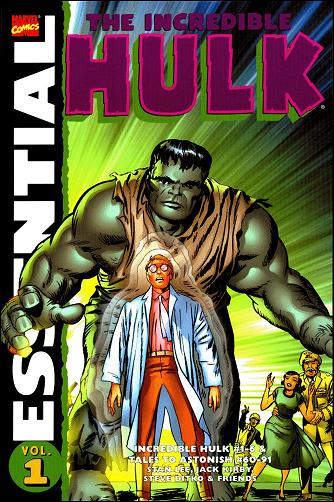
Essential Incredible Hulk Vol. 1
Stan Lee, Jack Kirby, Steve Ditko, Gil Kane and friends
Reprints: Incredible Hulk #1-6 & Tales To Astonish 60-91 (May 1962 – Arpil 1967)
Get this for: historical value rather than entertainment — Three stars
The Incredible Hulk was the second superhero title an still embryonic Marvel Comics would bring out, as Stan Lee and Jack Kirby hoped to make lightning strike twice after the succes of the Fantastic Four. Instead it was cancelled after only six issues and the Hulk would remain without his own series for more than a year, when he got a stint as the backup feature in Tales to Astonish. If you wonder why the Hulk failed to catch on when the Fantastic Four was such a succes, wonder no more: those first six issues are awful. Lee’s not so much writing, as overwriting the series, the plots are pedestrian and the whole gimmick of the series doesn’t work.
The idea behind the Hulk is great, an updated Jeckyl and Hide with the shy brainy scientist morphing into the monster-hero whenever he gets excited, the execution is just lousy. It’s obvious Stan Lee couldn’t quite make his mind up what to do with the Hulk, make him into a real villain or keep him as the same sort of easily angered anti-hero like the Thing, but it’s all a far cry from the fundamentally innocent childlike nature of the “classic” Hulk. The setting doesn’t help either, much too claustrophobic, each issue’s story having to be set around the army’s continuing hunt for the Hulk and Bruce Banner attempts to keep his being the Hulk a secret. And then there are the villains. The Fantastic Four had the Mole Man, the Skrulls, Miracle Man, the Sub-Mariner and Doctor Doom in its first six issues: Hulk has a Russian spy called the Gargoyle, the Toad Men, Ringmaster, Tyrannus and the Metal Master. It’s no contest, is it?
Once the Hulk returns, in Tales to Astonish, things start picking up. For a start, instead of Kirby as the artist, who made the Hulk too monstrous, it’s Steve Ditko, whose more fluid style fits the Hulk better. Kirby does return later, but by then the Hulk’s look has already been established. Still later there’s Gil Kane, who has an angular, elongated style just as effective as Ditko’s, if completely different.
The writing starts picking up as well. Having less space helps, forces Lee to cut some of the fat, while by now he has a much firmer handle on who the Hulk is supposed to be. A monster sure, but one who is kind at heart, just misunderstood by the world around him. There’s also more continuity between the stories, breaking away from the whole “hide from the army” aspect of the earlier series, though that’s still present as well. You got a great villain in the Leader (starting from Tales to Astonish #63), another man mutated by gamma radiation like the Hulk but who has gotten super intelligence rather than superstrength. You also got two other classic villains in this volume: the Boomerang (TTA #81) , later better known as a Spider-Man villain and the Abomination (TTA #90), an even more hideous gamma ray monster than the Hulk even…
There’s also some sloppiness however. At one point the Hulk is transported into “the future”, where he ends up fighting the Executioner who is trying to conquer the world for some reason best known to himself, but after two issues of doing so he drops back into the present, the Executioner forgotten. In a similar way Rick Jones, the Hulk’s teenage sidekick is a prisoner of the army in one issue, a free boy the next with no explenation other than having general Thunderbolt Ross (the Hulk’s nemesis and father of Bruce Banner’s love interest Betty Ross) instructing his men to keep an eye on him…
So: the incredible Hulk stories are boring, the Tales to Astonish ones are fun if sloppy at times, neither is the best Marvel’s Silver Age had to offer. Not quite an essential volume then, if interesting in seeing how the Hulk is developed, not quite the character we all know yet.
Tweets that mention Fifty Essentials in Fifty Days 04: Incredible Hulk Vol 1 | Wis[s]e Words -- Topsy.com
September 14, 2010 at 4:42 am[…] This post was mentioned on Twitter by Martin Wisse, Marvel Mistress. Marvel Mistress said: Incredible Hulk! Fifty Essentials in Fifty Days 04: Incredible Hulk Vol 1 | Wis[s]e …: The Incredib… http://bit.ly/cH30q1 #marvelcomics […]